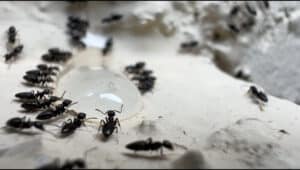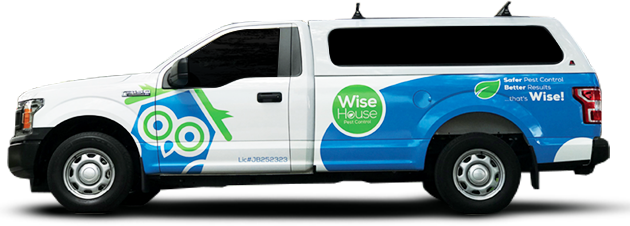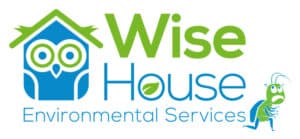White-footed ants are a common pest in South Florida, infamous for their ability to quickly overrun homes and businesses. These tiny pests are notoriously difficult to control as they typically build multiple nests and forage tirelessly for food. However, understanding their behavior and vulnerabilities is the first step in safeguarding your home or business.
In this blog post we look at the white-footed ant’s biology, habits, and the reasons behind their attraction to our homes. We will then cover some practical and effective strategies for preventing infestations. Whether you’re a South Florida homeowner looking to safeguard your property or a business owner.

The white-footed ant, also known as Technomyrmex difficilis, is a pervasive ant species in South Florida, recognized by its small size (2.5-3mm) and distinctive pale feet. These ants are highly adaptable, thriving in both urban and rural environments, and are known to establish expansive colonies with multiple queens. This, combined with their ability to reproduce rapidly, makes them a challenging pest to control.
Indoors, white-footed ants often nest in wall voids, under appliances, and within electrical equipment. Outdoors, they can be found in a variety of habitats, including tree bark, leaf litter, and soil. These ants are omnivorous, feeding on a wide range of food sources, including honeydew, nectar, and insects. Their opportunistic feeding habits and ability to exploit a variety of resources contribute to their success as an invasive species in South Florida.
While not typically considered a health hazard, white-footed ants can sometimes contaminate food and surfaces with bacteria. Their large numbers and persistent foraging behavior make them a nuisance in homes and businesses. They are particularly attracted to sweet substances and can quickly infest kitchens and pantries, leading to potential food contamination.
Identifying South Florida White-Footed Ants is highly important when it comes to managing and preventing infestations. Here are key characteristics to help you recognize these ants:
Color – White-Footed Ants have a distinctive coloration with a dark brown to black body and pale, yellowish-white feet.
Size – They are relatively small, measuring about 2.5 to 3 mm in length.
Shape – They have a segmented body with a single node on their petiole, and their antennae are 12-segmented without a club.
Nesting – White-Footed Ants typically nest in moist environments. Outdoors, they can be found under loose bark, in leaf litter, or in decaying wood. Indoors, they may nest in wall voids, under carpets, or near moisture sources.
Feeding – These ants are attracted to sweet substances and are commonly seen foraging for sugary foods. They tend to form long trails of workers leading to food sources.
Movement – White-Footed Ants move slowly compared to other ants and often travel in large numbers.
White-Footed Ants thrive in warm, humid climates and are commonly found in South Florida. They can infest both outdoor and indoor areas, making homes, gardens, and greenhouses their primary locations.
Trails – Look for long lines of ants foraging from their nests to food sources.
Moisture – Check areas with high moisture levels, such as kitchens, bathrooms, and outdoor areas with decaying organic matter.
Egg Clusters – White-Footed Ants often transport their eggs and larvae along their foraging trails. Finding clusters of tiny white eggs can be an indication that there is a nest nearby.
Indoor Nests – Indoors, they often nest in wall voids, under carpets, inside potted plants, or near other moisture sources like kitchens, bathrooms, and basements.
Swarmers – During certain times of the year, you may observe winged ants, or swarmers, which are reproductive members of the colony looking to establish new nests. The presence of these swarmers can indicate a mature infestation.
Patience and persistence are key when dealing with white-footed ants. By doing the following steps and remaining vigilant, you can successfully remove white footed ants from your South Florida home and prevent future infestations.
Thoroughly inspect your home and garden to locate ant trails and nesting sites. Check under loose bark, in mulch, leaf litter, and moist areas inside your home such as wall voids and under carpets.
Place sweet-based ant baits near trails and nesting sites. Worker ants will carry the bait back to the colony, which helps eliminate the entire nest. Ensure that you follow the bait product instructions carefully for the best results.
Consider hiring a professional pest control service for severe infestations. They can apply more targeted treatments effectively and safely.
Keep your kitchen and dining areas clean, wiping down surfaces, and promptly cleaning up spills and crumbs. Store food in airtight containers and ensure that pet food is not left out.
Inspect your home thoroughly for cracks and gaps around windows, doors, pipes, wires, and foundations. Use caulk to seal smaller openings and expanding foam for larger gaps. Repair or replace damaged weatherstripping around doors and windows to create a tight seal.
Maintain Cleanliness: Regularly sweep, vacuum, and mop floors, especially in kitchens and dining areas. Wipe down countertops, tables, and other surfaces where food may have been prepared or consumed.
Proper Food Storage: Store food in airtight containers, including pet food. Avoid leaving open food containers or crumbs on counters and tables. Clean up spills immediately.
Regular Trash Disposal: Dispose of garbage regularly in sealed containers. Clean trash cans frequently, both inside and out.
Moisture Control: Repair leaky pipes and faucets promptly. Ensure proper drainage around your home’s foundation to avoid standing water. Reduce humidity indoors by using dehumidifiers or air conditioners.
Landscaping Maintenance: Trim trees and shrubs away from your house to prevent them from serving as bridges for ants. Remove debris like leaves, woodpiles, and rocks from your yard, as these can provide nesting sites.
Perimeter Treatments: Apply a barrier of granular or liquid insecticide around the perimeter of your home. This creates a protective zone that deters ants from entering.
Regular Inspections: Periodically inspect your home for signs of ant activity, especially in areas like kitchens, bathrooms, and basements. Early detection allows for prompt treatment and prevention of infestations.
While white-footed ants are not known to sting or bite, they can contaminate food and surfaces. It’s best to keep children and pets away from areas where ants have been seen to avoid potential ingestion of contaminated food.
White-footed ants establish multiple nests, both indoors and outdoors. It’s common for foraging ants to travel long distances from their nests in search of food. Follow their trails as far as you can to try and locate the nest. If you can’t find it, Call a professional pest control company to help locate nests and safely remove these pests from your home.
White-footed ants do not typically cause structural damage to homes. However, they can nest in wall voids and electrical outlets, which may cause minor disruptions.
The timeframe for eliminating a white-footed ant infestation can vary depending on the size of the colony.
Yes, by maintaining a clean environment, promptly addressing moisture issues, sealing entry points, and continuing to use preventative measures like bait stations, you can significantly reduce the risk of re-infestation. Regular inspections are also important for early detection and prompt treatment.

Ready to send away pests without harming your pets? Getting started with Wise House Environmental Services is as easy as 1-2-3:
With Wise House Environmental Services, you get more than just effective pest control; you get peace of mind, knowing that your home is without pests and safer for your pets.
Our approach to pest control combines science with safety, offering you the kind of targeted, effective solutions that you won’t find with just any other pest control service. Our services have made a world of difference for homeowners, and we can do the same for you. Your pets will thank you for it!
We serve Port St. Lucie,Lake Worth, Boyton Beach, Palm Beachand the Treasure Coast.


© 2023 All Rights Reserved. | Sitemap